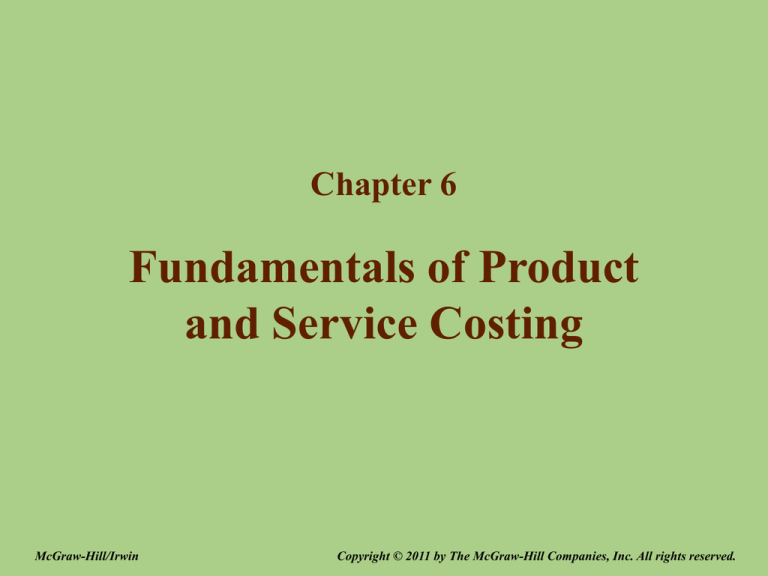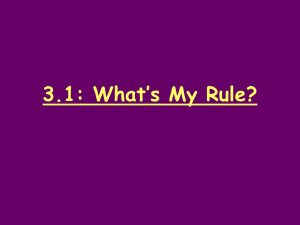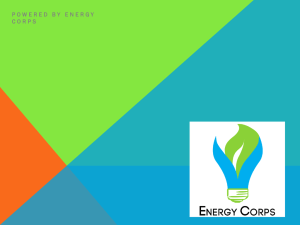
Chapter 6
Fundamentals of Product
and Service Costing
McGraw-Hill/Irwin
Copyright © 2011 by The McGraw-Hill Companies, Inc. All rights reserved.
Cost Management Systems
L.O. 1 Explain the fundamental themes underlying
the design of cost systems.
• The objective of the cost management system
is to provide information about costs relevant
for decision making.
• The cost system accumulates and reports costs
about processes, products, and services.
6-2
LO1
Reasons to Calculate Product
or Service Costs
• For decision making
• For deciding what to sell
• For setting prices
• For knowing the cost of goods sold
• For knowing the cost of inventory
6-3
Cost Allocation and Product Costing
L.O. 2 Explain how cost allocation is used
in a cost management system.
Basic Cost Flow Diagram
Cost
pools
Direct
materials
Direct
labor
Manufacturing
overhead
Indirect
Cost
allocation
rule
Cost
objects
(allocated
by direct
labor cost)
Direct
Alpha
Beta
6-4
Basic Cost Flow Model
L.O. 3 Explain how a basic product costing system works.
• How costs and units move through inventories:
Beginning
balance
+
Transfers
in
–
Transfers
out
=
Ending
balance
BB
+
TI
–
TO
=
EB
• This is true for the following accounts:
– Raw Materials (RM)
– Work-in-Process (WIP)
– Finished Goods (FG)
6-5
LO3
Costing with No Work-in-Process
Inventories
• Baxter Paint begins production on April 1.
• It starts and completes production of 100,000
gallons of paint in April and has no ending
work-in-process inventory.
Cost of resources used in April:
Materials
Labor
Manufacturing overhead
Total
$ 400,000
100,000
500,000
$1,000,000
6-6
LO3
Costing with No Work-in-Process
Inventories
• What are the costs at the end of the period?
• $1,000,000 was added to work-in-process
and then transferred out to finished goods.
• Since Baxter produced 100,000 gallons of
paint, then the cost per gallon of paint is $10.
6-7
LO3
Costing with Work-in-Process
Inventories
Production for Baxter Paint for May follows (gallons):
Beginning inventory
Started in May
Total
Ending WIP (50% complete)
Transferred out
-0110,000
110,000
20,000
90,000
6-8
Costing with Work-in-Process
Inventories
LO3
BB
0
+
TI
–
110,000
+
–
gallons
TO
90,000
gallons
=
EB
20,000 gallons
=
(50% complete)
FG
6-9
LO3
Costing with Work-in-Process
Inventories
• How do we cost Baxter’s 20,000 gallons of paint that
are only half finished?
• 20,000 gallons half finished is equivalent to 10,000
gallons finished.
• 90,000 gallons transferred out plus 10,000 equivalent gallons
of finished paint equals 100,000 equivalent gallons of paint.
Gallons of paint transferred out
Equivalent gallons of finished paint
Total equivalent gallons of paint
90,000
10,000
100,000
6 - 10
LO3
Costing with Work-in-Process
Inventories
Direct material + Direct labor + Overhead
($990,000)
90,000
gallons
(90%)
Equivalent gallons
Finished goods
inventory
$891,000
10,000
gallons
(10%)
Work-in-process
inventory
$99,000
6 - 11
Predetermined Overhead Rates
L.O. 4 Understand how overhead cost is allocated to products.
• Indirect costs are allocated using a predetermined
overhead rate (POHR).
• POHR is the cost per unit of the allocation base used
to charge overhead to products.
POHR = $ ÷ Base
6 - 12
Multiple Allocation Bases
and Two-Stage Systems
L.O. 5 Explain the operation of a two-stage allocation
system for product costing.
• We can use two or more allocation bases to allocate
manufacturing overhead to products.
6 - 13
LO5
Cost
pool
Multiple Allocation Bases
and Two-Stage Systems
Manufacturing overhead
First stage
Machine-related
costs
Direct labor-related
costs
Cost
allocation
rules
Indirect costs
Indirect costs
(allocated in proportion
to machine hours)
(allocated in proportion
to direct labor costs)
Cost
objects
C-27s
C-20s
Second
stage
6 - 14
Multiple Allocation Bases
and Two-Stage Systems
LO5
Overhead
$180,000
Cost
pool
Intermediate
cost pools
Labor-related
$108,000
Machine-related
$72,000
Cost allocation
rule
Direct labor
costs
Machine
hours
6 - 15
Product Costing Systems
L.O. 6 Describe the three basic types of product costing
systems: job order, process, and operations.
• Job costing:
– An accounting system that traces costs to individual units
or to specific jobs, contracts, or batches of goods.
(custom homes, movies, services)
• Process costing:
– An accounting system used when identical units are
produced through a series of uniform production steps.
(cornflakes, facial tissues, paint)
6 - 16
End of Chapter 6
McGraw-Hill/Irwin
Copyright © 2011 by The McGraw-Hill Companies, Inc. All rights reserved.







